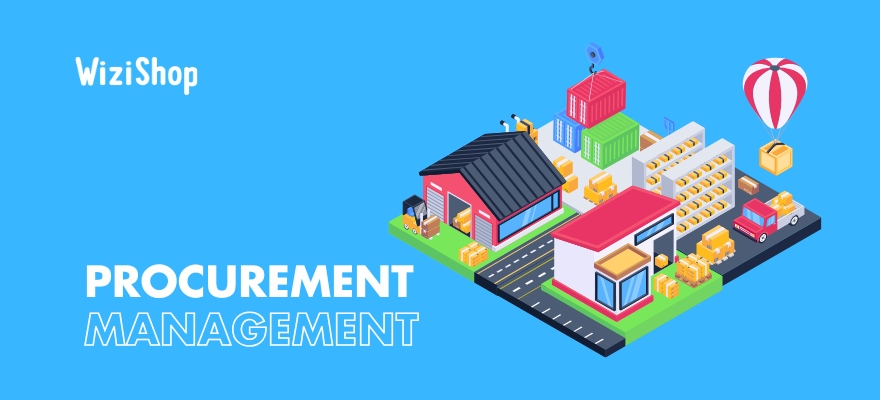For companies, procurement management is an essential and central element of their logistics. To be profitable, companies must not overstock. They must find ways to sell their inventory and order accordingly or choose more appropriate supply methods.
On the other hand, to help meet customer demand, companies must not be out of stock either. In this context, everything is a question of balance and organization. This key aspect of logistics can get even more complicated for companies that sell products on a global scale.
So, how do you properly manage these crucial details of operations for your ecommerce business? Read on to learn more!
What is procurement management?
Procurement management is a strategic function for companies. This key step of ecommerce logistics corresponds to the sourcing and purchasing of goods and their storage for resale. Let's take a closer look and see what it is and what are the different methods that serve as solutions to manage it in the best way possible for your business.
Definition of procurement management
Procurement management is a process that aims to meet the company's needs for products or services. It involves finding and storing whatever is needed for the company's operations, whether it is finished goods, merchandise, raw materials, or parts. The supplies are then processed and/or stored, before being resold.
Depending on the type of company and industry, procurement management can take different forms and include various systems and processes. For example, for a craftsperson, it may involve purchasing materials that will then allow them to manufacture their products. For a start-up, it consists of buying parts to manufacture a technological product. For an ecommerce company, procurement management involves the purchase of products and their storage, before they’re purchased by internet users.
What are the objectives of procurement in the supply chain?
The objectives of procurement in the supply chain are to acquire high-quality goods and services at the best possible cost while ensuring timely delivery and maintaining strong supplier relationships. Procurement plays a critical role in optimizing costs, reducing risks, and ensuring a smooth flow of materials, ultimately supporting business efficiency and profitability.
Effective procurement management is crucial because it directly impacts production timelines, product quality, and overall supply chain resilience. A well-managed procurement strategy helps mitigate supply chain disruptions, negotiate better terms with suppliers, and improve cost efficiency. It also ensures compliance with regulatory and ethical standards, preventing issues related to labor practices or environmental impact.
In addition, procurement teams must leverage data analytics and digital tools to enhance decision-making and streamline processes. By fostering collaboration with reliable suppliers and continuously assessing performance, businesses can create a robust and agile supply chain that adapts to market fluctuations and customer demands.
How to manage supplies: strategic principles
There are many different methodologies for managing the procurement of supplies. And let's be clear: no one method is better than another. In fact, the solution adopted must simply depend on the company's operations and its needs.
Demand-driven: The demand-driven supply management method is based on factual information.
Several solutions coexist:
- Calendar method: with this model, it’s a question of ordering a precise quantity of products at a date fixed in advance, to supplement the missing stock and to ensure the restocking, according to the sales carried out on the preceding period.
- Just-in-time (JIT) method: it consists of limiting inventory costs by buying products only on demand. There is then no anticipation with this model, which makes it possible to limit waste and to optimize the cash flow. On the other hand, in this case, it’s essential to rely on agile and very reactive providers.
- Kanban method: in this case, a minimum stock is defined. From this, purchases are made progressively, according to the volume of orders sold, so as to always maintain the same stock. This is a pull-flow operation that reduces production and storage costs, while offering excellent product traceability.
- Order point method: this method also imposes the setting up of a minimum security stock. When this is reached, a new supply is automatically triggered. With this model, overstocking is impossible.
While the previous modes of management were essentially based on factual and on concrete orders, it’s also possible to anticipate the needs of the customers and stock management in ecommerce with solutions based on calculations and data analyses:
- Empirical method: this is based on the requests made to suppliers during the previous year. It’s a question of observing the budget allocated to the orders and the quantities bought previously to be inspired, in order to satisfy the future needs of the company.
- Forecasting method: very similar to the empirical method, the forecasting method is also based on the analysis of the previous year, while adding market studies and competitive analyses. The supply management then takes into account the purchases already made, while projecting the evolution of future orders.
What are the steps in procurement management?
Procurement can be a long and complex process, whether it’s for traditional commerce, digital commerce, or ecommerce, involving many players. Procurement management involves a structured process to ensure the efficient acquisition of goods and services. By following these steps, organizations ensure that procurement aligns with their operational needs, cost goals, and long-term business strategy.
1. Identify your business needs
First of all, it’s essential to estimate the needs of your company for each good or service. Identifying your material expectations must be the basis of your procurement management. Moreover, this concerns not only your company's internal needs (useful for creating your products and ensuring your smooth operation), but also its external needs (intended for sale).
2. Find your suppliers
Surrounding yourself with good service providers is also an essential phase. In this sense, you need to find one or several good suppliers, respecting the standards in force as well as the qualitative criteria imposed by your company. In the same way, your partner must show reliability and reactivity. They must also offer you a competitive price. In the long run, your partnerships with your suppliers must be based on a win-win relationship, in which everyone benefits.
3. Negotiate and finalize contracts
To make the right choice, don't hesitate to compare the different offers between them, revealing all the data and details concerning their manufacturing services, and be sure to take the time to read the fine print to determine the best option for your company and its operations.
Moreover, this comparison will allow you to negotiate the prices of your goods. At the end of this step, you should have defined a price with your supplier. It’s also at this point that the production and delivery terms will be clearly established and the contract will be signed.
4. Create purchase orders
Now that everything is in place, the production of your inventory can begin! Your company is now in a position to finalize its order. After the legal contract between you and your partner has been finalized, your supplier can start the industrial production of the stock.
This means that you'll need to create a purchase order, a document detailing the product or service specifications, quantities, pricing, and delivery terms. Also be sure that, if necessary, any required internal approvals are obtained before sending the order to the supplier.
5. Get orders fulfilled and monitor supplier performance
Next, the supplier processes the order and delivers the goods or services as per the contract. During this step, you'll need to track the order status, delivery timelines, quality standards, and adherence to terms.
Continuous monitoring helps identify issues like delays or defects early, allowing corrective action. This step is crucial for maintaining supply chain efficiency, minimizing disruptions, and ensuring cost-effectiveness, ultimately supporting business operations and customer satisfaction.
6. Receive and inspect goods
Product delivery is also a key step in procurement management. Don't just store the boxes in your warehouse—remember to check all your items. This involves checking the quality of the products received, as well as the quantity and prices charged.
Goods should be inspected upon arrival to verify they meet quality and quantity requirements. Any discrepancies, damages, or defects are documented and addressed with the supplier.
7. Verify and pay invoices
The next step of the procurement management process involves recording the operation in the accounting system. At this stage, accuracy is essential. Accurate accounting makes quarterly inspections easier. It’s also the way to help avoid inventory discrepancies.
The supplier submits an invoice for payment, which is cross-checked with the purchase order and delivery receipts. Once verified, payment is processed as per agreed terms.
8. Manage supplier relationships
Maintaining and optimizing relationships with vendors to ensure smooth operations, cost efficiency, and consistent quality. This includes clear communication, performance monitoring, contract management, and resolving disputes.
Strong supplier relationships lead to better pricing, reliability, and innovation opportunities. Trust and collaboration can also help mitigate risks, such as supply chain disruptions or quality issues.
Effective supplier management ensures long-term success by fostering strategic partnerships that enhance operational efficiency, reduce costs, and improve service delivery. It ultimately contributes to a company’s competitiveness and ability to meet customer demands effectively.
9. Analyze procurement processes for continuous improvement
Finally, be sure to review procurement activities to identify inefficiencies, cost-saving opportunities, and areas for enhancement. This includes evaluating supplier performance, streamlining workflows, leveraging technology, and adopting best practices.
Continuous improvement helps reduce costs, improve quality, enhance supplier relationships, and increase operational efficiency. By regularly refining procurement strategies, your business can adapt to market changes, mitigate risks, and ensure a more agile and competitive supply chain.
Procurement management is essential to ensure an online store’s profitability. In 2019, about 30% of companies' expenses were wasted due to an inappropriate purchasing system. In addition, anticipating your needs in the outsourcing of ecommerce logistics can also help to achieve economies of scale.
This has a direct impact on the company's bottom line. Besides the implementation of effective communication, the development of a loyalty strategy, and well-planned ecommerce returns management, procurement management has direct consequences on your revenue, whether your business sells products locally or on a global level.










